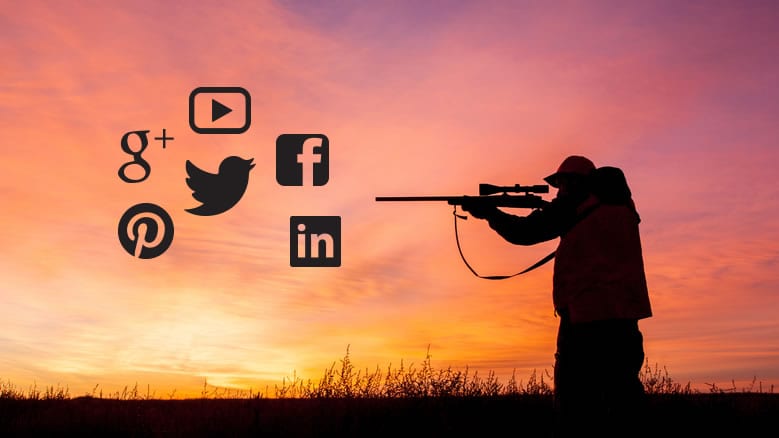
The biggest shopping weekend of the year is coming up and now is the time to begin preparing.
U.S. Thanksgiving and Black Friday online sales last year totaled over $1.7 Billion in 2015. And with background checks setting new records in the firearm industry last year with 185K, you can bet that this year is going to be just as good or better. And a few industry resources of mine mentioned to me, although unverified—
- “For the first time, more people shopped online than store purchases”
(Black Friday 2015 –Dick’s Sporting Goods)
Assuming you’ve defined an offer on your website, whether it’s free shipping, a sales discount or you’ve arranged some kind of offer with your dealers, there is much you can do to boost this year’s Black Friday sales to get a piece of the action.
Below are four ideas to help you move the needle for your hunting, outdoor or firearms business—based on latest online retail statistics and what other savvy companies are doing to boost Black Friday sales.
1. Segment your email campaign
If you’re planning to send a blanket email to your subscriber list, you may want to take a step back and reevaluate. Sending blanket emails may work if you sell only one multi-use product, but if you have multiple buyer personas, who buy your product—you’ll need to segment those customers and tailor those messages to their preferences to make your email campaign more effective.
According to Mailchimp, segmented emails perform markedly better than non-segmented emails:
- 14.1% more opens
- 59.82% more clicks
- 8.86% lower unsubscribes
“When we first started with digital marketing, we were one of those companies that would send a one-size-fits-all message to everyone,” says Matteo Recanatini, Beretta’s Digital & Ecommerce Manager. “We needed a more effective way to identify the different lifestyles and preferences of our customers and deliver content that actually mattered to them through different channels.” (Source: Hubspot)
What if I haven’t been segmenting?
If you haven’t been segmenting your contacts through some kind of marketing automation software, and you have no idea who your subscribers are, then the next best thing is to get busy setting up individual landing pages per persona and offer an incentive or discount code so you can begin gathering this information. Create a form on your landing page that asks what their interests are and how they use your product for better understanding. After the initial blast, be ready to send a personalized email to those segments to increase engagement. Once they fill out the form, direct them to a thank you page for them to claim their offer, whether it’s an ebook, whitepaper or even a coupon code. Your product may be one-size-fits-all, but your customers may have different interests. Figure out what those differences are and create personalized emails based on solving their problems or providing solutions while attaching a discounted sales price.
Don’t forget an attention-grabbing subject line.
Subject lines are critical—33 percent of subscribers decide whether or not to open your email based on the subject line alone. With email volumes increasing exponentially around the holidays, your subject line needs to work even harder to get potential shoppers to open your email and take action.
- Stand out: Using emoji
 can boost open rates.
can boost open rates. - Be festive: Beyond emoji, use words like “Holiday Sale” for promotions. Holiday-themed open rates tended to be higher.
- Ask a question: “Ready to knock out your holiday shopping?” or “What will you do with your 50 percent off holiday coupon?”
- Make it urgent: Emphasize pending deadlines like “Cyber Monday Sale ends today” or “Holiday door-busters till noon only.”
(Source: iMedia)
2. Send dealer locations
For hunting or firearms manufacturers who choose to downplay their online sales, you may want to help your dealers out by sending their offers to your subscriber list and then segment those dealers by location, so your subscribers know where to go to buy your products. Create some urgency around the sale and send them the address and store hours so they know where to go. This can also help you build stronger relationships with your most important buyers and show you care about them.
3. Put your deals on the home page
Americans plan to do almost half of their holiday shopping online this year, and one in five of those who own smartphones will use them to purchase holiday merchandise, the highest since NRF first asked in 2011. (Source: NRF)
If you have a website that is somewhat extensive, you may want to run your deals directly on your home page with a quick checkout option or link to your dealer locator. Make it simple and quick to take advantage of the shopping frenzy.
4. Get mobile now
For the first time, online traffic from mobile devices outpaced traditional PCs on Thanksgiving Day. As IBM predicted within one percent of accuracy, Thanksgiving Day reached a new mobile tipping point with smartphones and tablets accounting for 52.1 percent of all online traffic. Overall Thanksgiving online sales were up 14.3 percent compared to 2013. (Source: IBM)
If you haven’t gotten your website converted to a responsive platform—meaning that it renders well on tablet and mobile devices—you’ve limited your brand’s ability to take advantage of almost half of all internet traffic and potential online sales. (Source: Search Engine Land) The best hunting and firearm websites in the industry have converted over and so should you as soon as possible if you haven’t already.
Men say they always use mobile devices to check prices while shopping in stores versus just five percent of women. (Source: Kellogg Shopper Index)
Mobile will play a critical shopping role today, Saturday, and Sunday, with an estimated 60 million consumers planning to use their devices to shop, research purchases, or seek retailer information. (Source: InMobi)
If your site isn’t mobile, a quick fix is to redirect all web queries to a mobile-optimized page using the keywords of your deals during Thanksgiving through Cyber Monday and place your offers directly on that page.
Don’t forget to utilize your social media channels to amplify your sales and drive traffic.
So in conclusion, segment your emails to increase engagement, help your dealers out, put your deals on your home page for fast and easy checkout and make sure your site is mobile-ready to capture those in-store searches.





